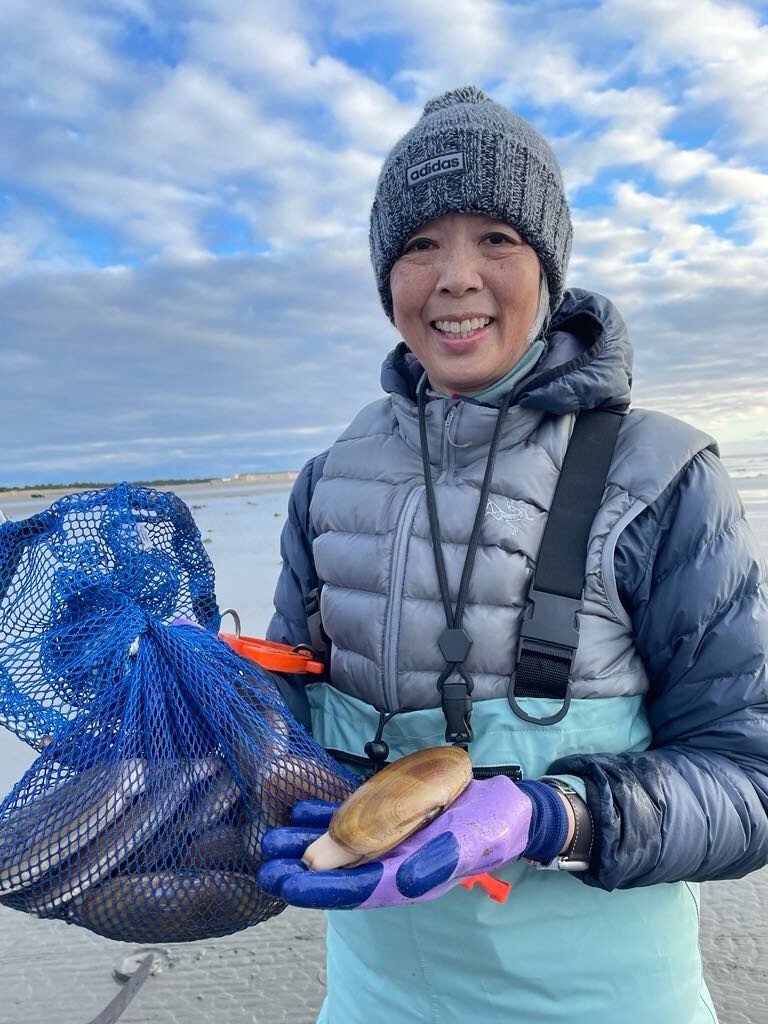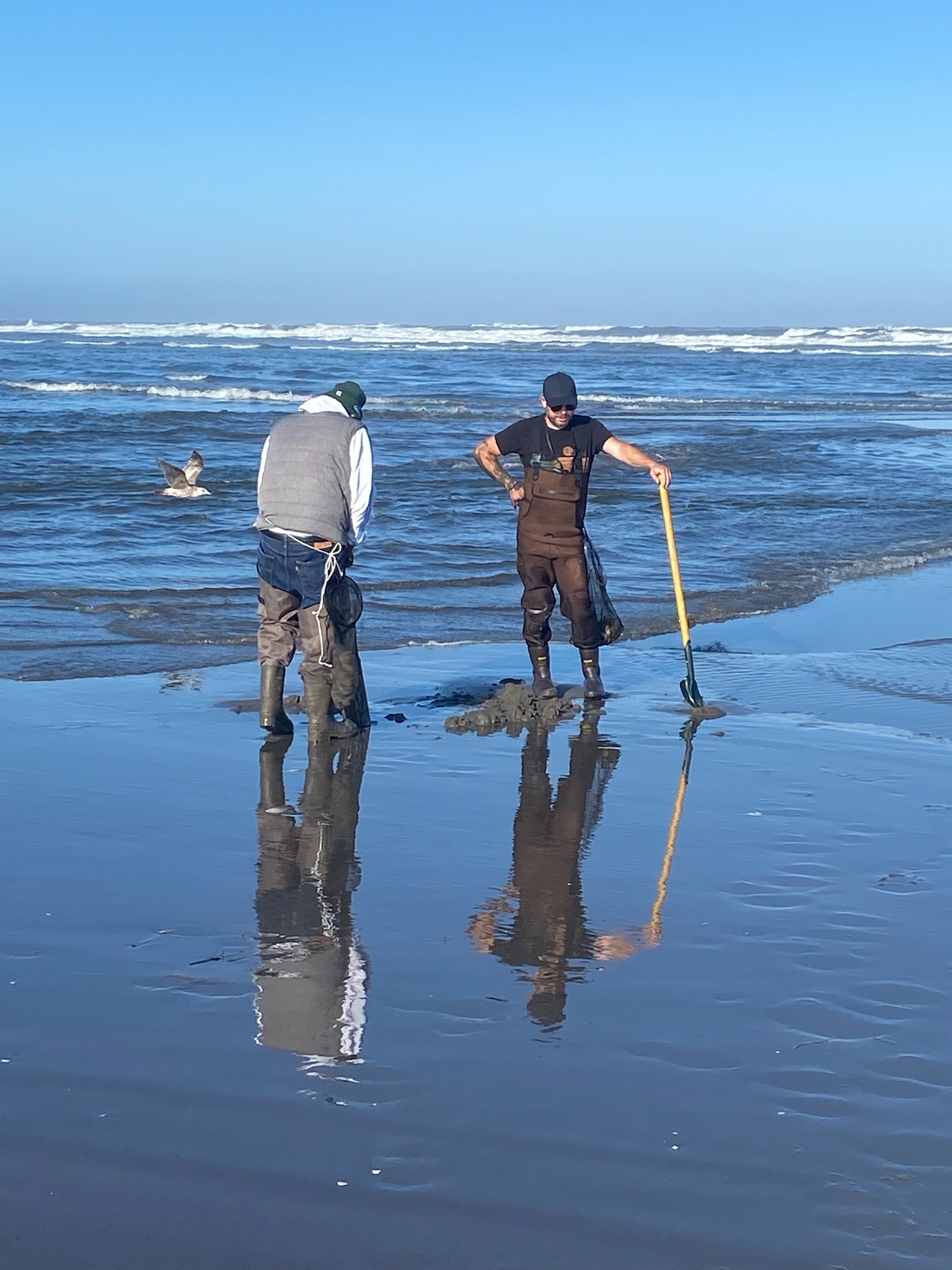RAZOR CLAMMING HIGHLIGHTS

Spring digs are underway!
Take advantage of the daytime digs and spring weather
By Lynn Munson/WDFW
Razor clam diggers can look forward to more digging on coastal beaches, Washington Department of Fish and Wildlife coastal shellfish managers have confirmed.
The Washington Department of Health (DOH) requires test samples for marine toxins, and domoic acid levels must fall under the guideline level before a beach can open for digging. Domoic acid, a natural toxin produced by certain types of marine algae, can be harmful or fatal if consumed in sufficient quantities. Final approval usually occurs about a week or less – sometimes two to three days – before the start of each digging series. More information about domoic acid, as well as current levels at ocean beaches, can be found on the WDFW’s domoic acid webpage.

Spring razor clamming near Westport. (WDFW)
On all open beaches, the daily limit is 15 clams per person. Each digger’s clams must be kept in a separate container, and all diggers must keep the first 15 clams they dig, regardless of size or condition.
Not all beaches are open for every dig, so diggers are encouraged to make sure their intended destination is open before heading out. For more information on these digs, go to WDFW’s razor clam webpage.

Submit your razor clamming photos!
Are you a clam gun guru or a shovel superstar? It’s time to prove your razor clamming prowess!
Join the Razor Clam Face-Off and show off your skills. Snap a photo of your epic clam-digging adventure and submit it on our site using the hashtag for your team, #TeamClamGun or #TeamClamShovel, from the “Promotion” drop down menu.
Every week, we’ll feature a standout photo on our social media. The team with the most submissions will win bragging rights.
So, grab your license and gear, hit the beach, and let’s dig in!

Great razor clam digging and nice weather at Copalis Beach (Joni Mar Nakagawa)

A 91-year-old grandfather and his grandson clamming at Long Beach (Shelly Nash)
The following confirmed digs will proceed as scheduled, after marine toxin results from DOH showed razor clams are safe to eat.
Confirmed dates during morning (midnight to noon only) low tides:
- April 12, Saturday, 6:57 a.m.; 0.4 feet; Long Beach, Twin Harbors, Mocrocks
- April 13, Sunday, 7:29 a.m.; 0.0 feet; Long Beach, Twin Harbors, Copalis
- April 14, Monday, 8:00 a.m.; -0.2 feet; Long Beach, Twin Harbors, Copalis
- April 15, Tuesday, 8:33 a.m.; -0.3 feet; Long Beach, Twin Harbors, Mocrocks
- April 16, Wednesday, 9:08 a.m.; -0.2 feet; Long Beach, Twin Harbors, Mocrocks
- April 17, Thursday, 9:48 a.m.; 0.0 feet; Long Beach, Twin Harbors, Copalis
- April 18, Friday, 10:33 a.m.; 0.3 feet; Long Beach, Twin Harbors, Copalis
Tentative dates during morning (midnight to noon only) low tides:
- April 26, Saturday, 5:53 a.m.; -0.6 feet; Long Beach, Twin Harbors, Copalis
- April 27, Sunday, 6:40 a.m.; -1.5 feet; Long Beach, Twin Harbors, Mocrocks
- April 28, Monday, 7:25 a.m.; -2.0 feet; Long Beach, Twin Harbors, Mocrocks
- April 29, Tuesday, 8:12 a.m.; -2.2 feet; Long Beach, Twin Harbors, Copalis
- April 30, Wednesday, 9:00 a.m.; -2.0 feet; Long Beach, Twin Harbors, Copalis
- May 1, Thursday, 9:52 a.m.; -1.6 feet; Long Beach, Twin Harbors, Copalis
- May 2, Friday, 10:47 a.m.; -0.9 feet; Long Beach, Twin Harbors, Mocrocks (digging extended until 2 p.m.)
- May 3, Saturday, 11:48 a.m.; -0.2 feet; Long Beach, Twin Harbors, Mocrocks (digging extended until 2 p.m.)
Tentative dates during morning (midnight to noon only) low tides:
- May 10, Saturday, 5:58 a.m.; 0.1 feet; Long Beach, Twin Harbors, Copalis
- May 11, Sunday, 6:32 a.m.; -0.4 feet; Long Beach, Twin Harbors, Mocrocks
- May 12, Monday, 7:05 a.m.; -0.7 feet; Long Beach, Twin Harbors, Mocrocks
- May 13, Tuesday, 7:38 a.m.; -0.9 feet; Long Beach, Twin Harbors, Copalis
- May 14, Wednesday, 8:13 a.m.; -0.9 feet; Long Beach, Twin Harbors, Copalis
- May 15, Thursday, 8:49 a.m.; -0.8 feet; Long Beach, Twin Harbors, Mocrocks



